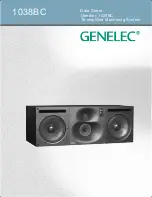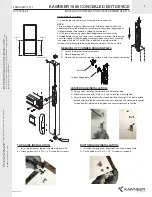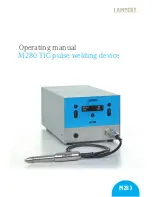
Figure 2: The curves above show the effect of the ‘bass’, ‘mid’ and
‘treble’ level controls, and the ‘bass tilt’ and ‘bass roll-off’ controls on the
free fi eld response, measured at 2 m.
Figure 4: Block diagram
of the 1038BC
Figure 3: The location of the acoustical axis of the 1038BC in horizontal confi guration
Figure 1: The curve group shows the horizontal directivity characteristics
of the 1038BC in its vertical confi guration measured at 2 m.
in the midrange frequencies, more direct
sound and less early boundary refl ections
are received at the listening position. This
results in more accurate stereo imaging and
makes the system less sensitive to differing
control room acoustics than any conventional
direct radiator design. The DCW Technology
improves drive unit sensitivity from +2 to +6
dB thus increasing the system maximum
sound pressure level.
Crossover fi lters
The crossover frequencies of the active
crossover network are 410 Hz and 3.0 kHz.
In order to obtain uniform frequency balance
under different acoustic conditions, special
calibrated controls are included in the cross-
over. The Bass, Midrange and Treble level
controls operate in 1 dB steps. Furthermore,
the low frequency Tilt and Roll-off controls
both have four 2 dB steps to allow refi ned
LF response tailoring. A high-pass fi lter is
included in the LF channel to protect the
woofer from subsonic signals. The crossover
network is driven by an active balanced input
stage, fed by a 3 pin XLR. Variable input sen-
sitivity allows for accurate level matching to
the mixing console.
Options
Order
code
Opt-09 Grille
1038-409BC






















